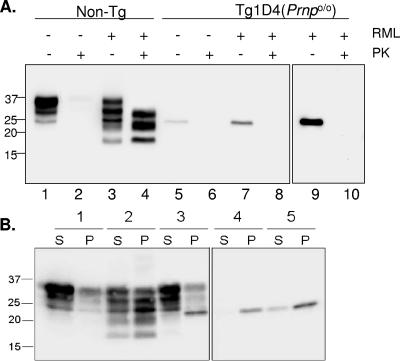FIG. 3.
cyPrP does not produce PK-resistant PrP. A. Western blot of brain homogenates from non-Tg and Tg1D4(Prnpo/o) mice inoculated with RML or vehicle and submitted to PK digestion. Non-Tg mice (lanes 1 to 4) were symptomatic with typical scrapie-like symptoms and died at ∼150 days, whereas the Tg1D4(Prnpo/o) mice (lanes 5 to 10) were killed at ∼500 days, following symptoms typical of the cyPrP phenotype. Brain homogenates were digested with 20 μg/ml PK, as described in the text. Sodium dodecyl sulfate-polyacrylamide gel electrophoresis was performed with a 14% acrylamide gel, and membranes were probed with the D13 antibody. PK-resistant PrP was evident in non-Tg homogenates, but not in Tg1D4(Prnpo/o) homogenates, even when the blot was significantly overexposed (last panel). B. Solubility characteristics of PrP from brains of mice expressing cyPrP. Supernatant (S) and pellet (P) fractions from brain homogenates of non-Tg (samples 1 and 2) and Tg1D4(Prnpo/o) (samples 4 and 5) mice in control (samples 1 and 4) and RML-inoculated (samples 2 and 5) mice were compared. The solubility profile of PrP in Tg1D4(Prnp+/+) mice is presented in sample 3. Note that cyPrP partitions nearly completely to the insoluble fraction, whether expressed in the presence or absence of PrPC. Samples 4 and 5 were run on the same gel but separated from the remainder of the samples.

